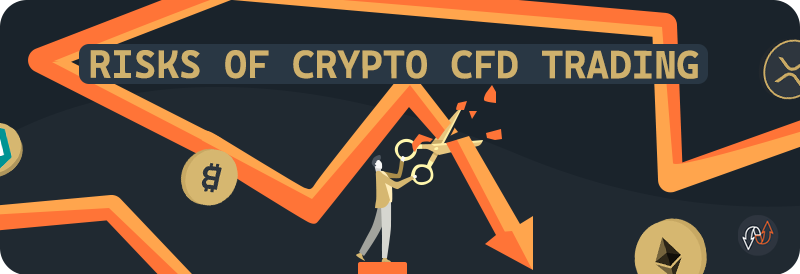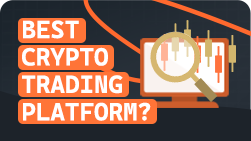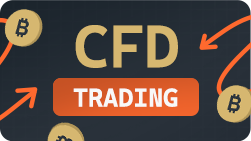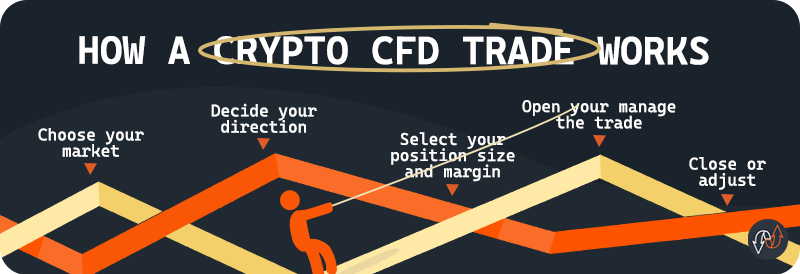Risks of Crypto CFD Trading
Crypto CFDs are one of the fastest-moving markets you can trade. The same volatility that makes them exciting also makes them risky, especially when combined with leverage. A single headline, exchange hack, or large market order can move Bitcoin or Ethereum several percent in minutes. When you’re trading on margin, those swings can magnify your profits or wipe out your account just as quickly.

That’s why it’s important to understand not just the trading risk itself, but also the crypto market and type of CFD broker you’re trading through. In countries like Australia, New Zealand, and across Europe, regulated brokers are required to follow strict rules that help protect retail investors. This includes limits on leverage, mandatory negative balance protection, and keeping client money separate from the broker’s own funds.
But, if you trade through an offshore broker, the high risk of crypto trading increases and you don’t get any of the retail investor protections mentioned. Leverage can be as high as 200:1, and if a trade moves against you, you could end up owing the broker money, not just losing your balance.
What are the risks involved in crypto CFD trading?
There’s significant risk involved in crypto CFD trading which mainly comes from leverage, volatility, liquidity, counterparty exposure, and overnight funding.
Leverage Risk
Leverage lets you open positions larger than your account balance. That can multiply profits but also losses. In jurisdictions with tier-one regulation such as Australia (ASIC) or Europe (CySEC), leverage on crypto CFDs is capped at 2:1.
This means if you have $1,000 in your account, you can open a $2,000 trade. If the price of Ethereum drops 10%, you lose $200, 20% of your balance. But because of negative balance protection, your loss can never exceed what’s in your account. Even if the market gaps down violently, your account is closed automatically before it goes below zero.
Now imagine that same trade on an offshore broker offering 200:1 leverage. Your $1,000 controls a $200,000 position so the potential profits are much higher. If the price falls just 1%, your entire balance is gone. If it moves 2% against you, you now owe the broker $3,000, and without negative balance protection, that debt is legally yours putting you in a precarious financial situation
This is why regulated leverage limits exist. They stop traders from blowing up accounts or going into debt during volatile conditions, which happen regularly in crypto.
Volatility Risk
Crypto markets can swing 5 to 10% in a few hours, particularly during major announcements or network events. Unlike forex or indices, there’s no central exchange to stabilise prices. Liquidity gaps can appear between order books, causing spreads to widen and slippage during execution. This means your stop loss might trigger further away from where you placed it, increasing your loss.
Liquidity and Slippage Risk
Liquidity in crypto CFDs is usually strong on major pairs like BTC/USD and ETH/USD, but it drops off quickly for smaller altcoins. During quiet trading hours or weekends, spreads widen and orders may fill at slightly different prices than you expected, this is called slippage.
Counterparty and Operational Risk
With CFDs, you don’t own the coins; you’re trading a contract with the broker. Regulated brokers reduce this risk by holding client money in segregated accounts with top-tier banks and publishing regular financial reports. Offshore brokers don’t follow these rules, which means you’re trusting them to stay solvent and honour withdrawals.
Swap and Holding Cost Risk
CFDs are designed for short-term trading, so holding positions overnight or for several days adds funding charges (called swaps). These fees accumulate daily and can eat into profits if you’re not factoring them in.
Is crypto riskier than forex trading?
Yes, crypto trading is riskier than forex trading because price swings are larger and liquidity can thin out at off-peak times, even though regulated leverage on crypto is lower than forex.
Crypto moves faster, trades 24/7, and can gap on weekends, so small mistakes with size or stops bite harder. By contrast, forex is deeper and usually more stable. At top-tier brokers, retail leverage limits reflect this: crypto is typically capped around 2:1, while forex majors can be up to 30:1 in regions like the EU, UK, and Australia. Offshore venues may offer very high leverage on both markets, which can make crypto exposure far more dangerous given its volatility.
What is the best crypto trading platform?
 The best platforms for trading crypto CFDs are MetaTrader 5 (MT5), MetaTrader 4 (MT4), and TradingView. Each has its own strengths depending on how you trade, whether you automate strategies, trade manually from charts, or use advanced analytics.
The best platforms for trading crypto CFDs are MetaTrader 5 (MT5), MetaTrader 4 (MT4), and TradingView. Each has its own strengths depending on how you trade, whether you automate strategies, trade manually from charts, or use advanced analytics.
All three support crypto CFD trading with top brokers like Eightcap, Pepperstone, and BlackBull Markets, and all offer demo accounts so you can test execution speed, spreads, and functionality before committing live funds.
MetaTrader 5
MT5 is the most complete CFD platform for crypto traders who want flexibility, automation, and detailed analytics. It supports multi-asset trading, which means you can manage crypto CFDs, forex, indices, and commodities in one trading account.
- Real-time CFD pricing feeds from multiple liquidity providers, so charts track live crypto markets 24/7.
- Depth of Market (DOM) data to view liquidity levels, useful during volatile crypto sessions when spreads widen.
- Integrated economic calendar and market news directly inside the platform to track market conditions and announcements.
- Support for algorithmic trading through MQL5, you can build, test, and deploy Expert Advisors (EAs) to automate crypto trading strategies such as breakout, mean reversion, or grid systems.
- VPS integration, which lets you keep EAs running continuously without downtime, key for crypto markets that never close.
- Strategy Tester for backtesting crypto pairs using tick-level data, allowing you to optimise position sizing and risk.
Some brokers like Eightcap also offer integrations for automation and trade management on MT5 such as Capitalise.ai and FlashTrader. For crypto traders running structured setups, MT5 is the most popular trading platform worldwide.
MetaTrader 4
MT4 remains widely used by CFD traders, especially those who value simplicity or already have automated systems built in MQL4. While it’s slightly older, MT4 still delivers fast execution, low latency, and solid stability across crypto pairs.
- Most brokers offer 24/7 crypto pricing with minimal lag, and spreads are clearly displayed in Market Watch.
- Dozens of crypto indicators and EAs are available in the MetaTrader marketplace, many free or low-cost.
- Simple one-click trading panel suits fast entries and exits during volatile crypto moves.
- Broker plugins extend functionality, for example, Eightcap’s FlashTrader integration brings advanced order management into MT4.
MT4 doesn’t have the same multi-threaded engine or order depth view as MT5, but it’s lighter and easier to customise. It’s a strong fit for discretionary crypto traders running basic setups or smaller portfolios.
TradingView
TradingView has become one of the most popular platforms for crypto CFDs thanks to its user-friendly interface, fast charting, and social trading community. Most leading CFD brokers like Eightcap and BlackBull Markets, now offer direct TradingView integration, so you can trade CFDs straight from charts using your broker login.
- Real-time CFD price feeds on crypto pairs like BTC/USD, ETH/USD, SOL/USD, and more.
- Pine Script editor lets you code and test trading strategies specific to crypto volatility and session behaviour.
- Custom alerts that can trigger based on technical conditions, volume spikes, or indicator crossovers, perfect for tracking crypto momentum.
- Multi-chart layouts to monitor several crypto pairs or timeframes side by side.
- Community ideas and public indicators from thousands of traders to find setups and compare analysis.
- Broker integrations for direct order execution, so you’re not switching between platforms.
- Sync across devices, you can chart on desktop and monitor or adjust positions from the mobile app.
TradingView’s combination of advanced analytics and ease of use makes it ideal for manual and semi-automated crypto trading. It’s particularly popular with CFD traders who want deep visual analysis but still rely on broker-side execution and regulation.
Other Ways to Access Global Markets
CFDs aren’t the only way to trade crypto, but they’re often the most accessible if you want leveraged trading, fast execution, or don’t want to manage wallets or exchange accounts. You can also trade through direct crypto ownership or via futures contracts, both forms of derivatives which have their place depending on how hands-on you want to be.
Crypto Coins
 Buying crypto coins directly on an exchange means you actually own the digital currency. You can hold it long term, move it to a private wallet, or use it in DeFi platforms. That ownership gives you flexibility but also adds operational risk, plus you’re responsible for storage, security, and any loss of access.
Buying crypto coins directly on an exchange means you actually own the digital currency. You can hold it long term, move it to a private wallet, or use it in DeFi platforms. That ownership gives you flexibility but also adds operational risk, plus you’re responsible for storage, security, and any loss of access.
Exchanges also operate differently to CFD brokers. They don’t offer negative balance protection, and there’s no regulation forcing them to segregate client funds. If an exchange is hacked or collapses, as seen with FTX and others, coins may not be recoverable. That’s one reason many short-term traders prefer CFDs, they get exposure to price movements without worrying about wallets or exchange solvency.
Crypto Futures
 Crypto futures are another way to trade digital assets, but they’re structured differently from CFDs. Instead of trading through a broker’s liquidity feed, futures are tied to exchange-based contracts with expiry dates and standardised sizes.
Crypto futures are another way to trade digital assets, but they’re structured differently from CFDs. Instead of trading through a broker’s liquidity feed, futures are tied to exchange-based contracts with expiry dates and standardised sizes.
Several prop firms, such as FundedNext and FXIFY, now give you access to both CFD and futures trading accounts for crypto and a range of other financial instruments. The key difference is that CFD trades run through the broker’s internal pricing feed, while futures are executed on external exchanges like the CME or Binance Futures.
Futures trading also comes with a bunch of extra costs, exchange data fees, clearing charges, and higher margin requirements, which can make them more expensive and complex. By comparison, CFD accounts are simpler to manage and provide the same price exposure without the exchange infrastructure.
For most, CFDs will remain the more practical choice. Futures suit those already familiar with exchange trading or who want to trade across asset classes in one connected system, but they require more setup, monitoring, and cost tracking than CFDs.

 A CFD, or Contract for Difference, is a financial agreement where you speculate on the price movement of an asset without taking ownership of it.
A CFD, or Contract for Difference, is a financial agreement where you speculate on the price movement of an asset without taking ownership of it.
 Bitcoin CFDs are the most actively traded in the crypto market. As the first and most widely recognised cryptocurrency, Bitcoin often sets the tone for the entire sector. When you trade a Bitcoin CFD, you’re speculating on BTC’s price against a fiat currency such as USD, EUR, or AUD.
Bitcoin CFDs are the most actively traded in the crypto market. As the first and most widely recognised cryptocurrency, Bitcoin often sets the tone for the entire sector. When you trade a Bitcoin CFD, you’re speculating on BTC’s price against a fiat currency such as USD, EUR, or AUD. Ethereum is the second-largest cryptocurrency by market capitalisation and the driving force behind most decentralised finance projects. When you trade an Ethereum CFD, you’re speculating on the price of ETH against a currency such as USD, EUR, or AUD without ever holding or transferring the coin yourself.
Ethereum is the second-largest cryptocurrency by market capitalisation and the driving force behind most decentralised finance projects. When you trade an Ethereum CFD, you’re speculating on the price of ETH against a currency such as USD, EUR, or AUD without ever holding or transferring the coin yourself. Altcoin CFDs cover the wider crypto market beyond Bitcoin and Ethereum. This group includes everything from long-standing projects like Litecoin (LTC), Ripple (XRP), and Cardano, to fast-moving networks such as Solana and Avalanche. Each coin has its own use case, community, and market behaviour, which makes altcoin CFDs popular with traders looking for variety and higher volatility.
Altcoin CFDs cover the wider crypto market beyond Bitcoin and Ethereum. This group includes everything from long-standing projects like Litecoin (LTC), Ripple (XRP), and Cardano, to fast-moving networks such as Solana and Avalanche. Each coin has its own use case, community, and market behaviour, which makes altcoin CFDs popular with traders looking for variety and higher volatility. Meme coin CFDs cover high volatility assets such as Dogecoin, Shiba Inu, and Pepe and come with the biggest risk warning. These coins don’t have the same fundamentals as Bitcoin or Ethereum and often move based on community hype, influencer activity, or broader social sentiment.
Meme coin CFDs cover high volatility assets such as Dogecoin, Shiba Inu, and Pepe and come with the biggest risk warning. These coins don’t have the same fundamentals as Bitcoin or Ethereum and often move based on community hype, influencer activity, or broader social sentiment. Crypto index CFDs combine several cryptocurrencies into one product, allowing you to trade a basket of crypto markets instead of a single coin. They typically include top assets by market capitalisation and give a good view of overall crypto sentiment.
Crypto index CFDs combine several cryptocurrencies into one product, allowing you to trade a basket of crypto markets instead of a single coin. They typically include top assets by market capitalisation and give a good view of overall crypto sentiment.
 The
The  Buying crypto coins directly on an exchange means you actually own the digital currency. You can hold it long term, move it to a private wallet, or use it in DeFi platforms. That ownership gives you flexibility but also adds operational risk, plus you’re responsible for storage, security, and any loss of access.
Buying crypto coins directly on an exchange means you actually own the digital currency. You can hold it long term, move it to a private wallet, or use it in DeFi platforms. That ownership gives you flexibility but also adds operational risk, plus you’re responsible for storage, security, and any loss of access. Crypto futures are another way to trade digital assets, but they’re structured differently from CFDs. Instead of trading through a broker’s liquidity feed, futures are tied to exchange-based contracts with expiry dates and standardised sizes.
Crypto futures are another way to trade digital assets, but they’re structured differently from CFDs. Instead of trading through a broker’s liquidity feed, futures are tied to exchange-based contracts with expiry dates and standardised sizes.